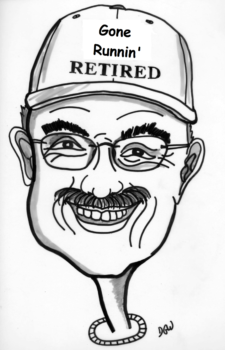The second most popular day for races is the Fourth of July. The country’s best-known July 4th race is the Peachtree 10 km in Atlanta. That race, limited to 60,000 runners, started in 1970.
Locally, the first known race was in 1979 with an unknown host organization.
The Battlefield Lions claim their race began in 1980 and used the same course as the 1979 event.
Since its inception, the race has started near the Visitor Center on Caroline Street. Until 1983, the course crossed over both main bridges into Stafford County and used River Road, finishing in Old Mill Park.
The reported distance of the race was 4.9 miles.

In 1983, the Lions developed a new course that stayed entirely in the city. They did not use USATF certification measuring methods but advertised the course as 5 miles.
Locals swore the course was 5.1 miles. When the race was included in the 1994 Big Five series, it was listed as such.
As part of the 1995 Coldwell Banker Elite Grand Prix series, we required all races to use a USATF-certified course. When we measured the predefined course, it was a few feet short of 5 miles. The hot days of early July seemed to make people feel they were running longer than advertised.

That year, the Fredericksburg Host Lions took over race management from the Battlefield Lions Club. They would manage it for the next 15 years.
In 1996, one of the best summer running days fell on the city. With temperatures in the low 60s and a 46-degree dew point, Jason Stewart finished in 24:07, which we consider the best male performance in the 320 Coldwell Banker Elite Grand Prix races. Bonnie Bernard-Lopez led the females in 28:41.
By 1998, the canal path was completed from the bottom of Fall Hill to Washington Avenue.
Wanting to get off the sidewalks of Jeff Davis Highway and College Avenue, we modified the course to use Caroline Street and Fall Hill Avenue to the path.

By 2008, the city wanted us to stop using Riverside Drive and Fall Hill Avenue. Between 2008 and 2014, four courses were used to bypass these roads and various construction projects. They still maintained a start and finish near the Visitor’s Center with the top of the loop in Normandy Village.
One aspect of the course that has never changed is the climb up Prince Edward Street hill from Wolfe Street to Charlotte Street in the last mile. This hill could make or break a runner’s race strategy,
The Heritage Trail, including the Fall Hill Avenue underpass, was completed in 2015. We’ve taken advantage of it ever since.

.In 2017, Tim Young took a shot at Jason Stewart’s best male race status but fell short by 6 seconds in 24:13.
In the spring of 2020, COVID shut down all road racing, and the Lions decided to cancel their race. Arsenal Events, which had acquired the assets of Race Timing Unlimited earlier in the year, worked with Stafford County to hold a socially distanced 4-mile race from the YMCA through Pratt and St Clair Brooks Park on the Belmont-Ferry Farm Trail.
They used the course previously used by the Sweethearts 4ever 4mile and John Robbins 4 Mile.

We had multiple lines with 6-foot stand-here marks for packet pickup.
There were multiple waves and a socially distanced starting grid. Based on our predicted finish time, we were assigned waves and a location in the grid.
We had to carry our own water, as it was not distributed on the course. When I passed, I surged to avoid running next to another person.
Post-race water and food were distributed in individual bags. Somehow, we survived.
For 2021, the Lions Club decided to give up race management, and the Fredericksburg Fallen Heroes organization took over the race.
For the past three years, the Fallen Heroes have used the 2015 course. However, participation is still low compared to pre-COVID numbers.
2022 was another low dew point weather year.
Now in its 46th year, early registration is up 17%.
July 4 is my favorite day to race.
